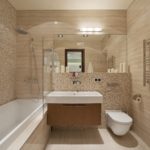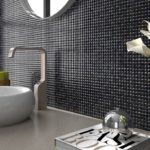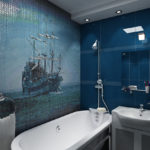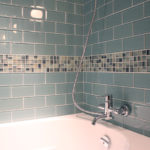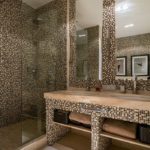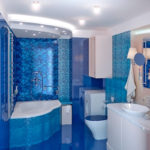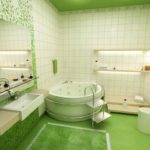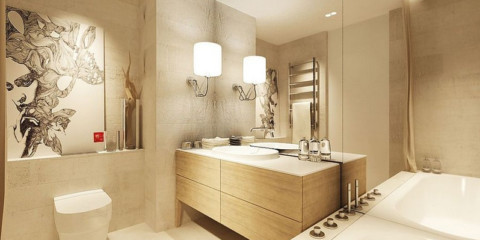 A bathroom
Tips for creating a harmonious 4 square meter bathroom design m
A bathroom
Tips for creating a harmonious 4 square meter bathroom design m
In planning bathroom repairs, special attention should be paid to the finishing work of walls and floors. High humidity, periodic temperature changes, possible mechanical effects on the walls - all these factors indicate the need for stability of the facing material to the above conditions. The combination of a bathroom with a toilet, which is so common in apartment buildings, requires surface simplicity in washing and resistance to the aggressive chemical environment of detergents. One of the best constructive solutions to this issue will be wall cladding with mosaics, since this material fully meets all the necessary requirements.

Mosaic in the bathroom opens up new opportunities for interior designers
Mosaic Benefits
Content
- Mosaic Benefits
- Design of a bathroom with a mosaic and its features
- Decorative mosaic elements as a “chip” of the bathroom
- The main types of mosaics in the interior of the bathroom
- The process of laying mosaic
- Rules and subtleties of facing, expert advice
- Watch a video with examples of mosaics in bathroom design:
- See 50 more photos of mosaic ideas in the bathroom:
In addition to its high functionality and undeniable beauty, the mosaic has several advantages over other facing materials.
- Practicality - the mosaic is very easy to wash even after heavy pollution.
- Durability - with proper installation, this material will serve the owner for a fairly long period.
- Resistance to changes in temperature and humidity.
- A wide range of products will make it possible to choose a mosaic for any style of the bathroom.
- Simplicity of facing - work with mosaics makes it possible to paste over any, even uneven surfaces, and also gives scope for imagination, allowing you to create a variety of ornaments.
- It is possible to clad surfaces of any material, whether it be concrete, plaster or wood.

The beauty of the mosaic decor is combined with its extreme practicality.
Among the disadvantages, the only aspect is the price of the lining, however, when taking into account depreciation over a long period of operation, this disadvantage is leveled and becomes more likely an advantage of this material.

Mosaic will retain its beauty for a long time, despite adverse operating conditions
Of course, mosaic is an ideal option for the interior of the bathroom due to its practicality, but do not omit the beauty that can be created thanks to this material. A lot of design ideas create a huge scope for the choice of style for the combined bathroom in a small Khrushchev, and for the design of a chic bathroom in a large house.

The decorative possibilities of the mosaic are endless
Design of a bathroom with a mosaic and its features
The design of the mosaic bathroom begins with the selection of material. There are several concepts of cladding, among which the most popular are the combination of mosaics with tiles and the creation of ornaments without the participation of tiles.

Mosaic and tile made for each other
Having decided on a room design project, you need to choose the shape, size and color of the mosaic. The main forms of tiles are square, rectangle, rhombus and oval. As practice shows, it is most convenient to work with a square mosaic measuring 10 * 10, 20 * 20 or 50 * 50 millimeters.

A large beige mosaic will make an excellent backdrop for the interior of the bathroom
The ornament of the picture can be varied.You can simply pick up your favorite color scheme in light or bright colors, imitation of marine patterns, various panels or ornaments throughout the wall. If the plumbing unit of the apartment is combined, it is worth designating the distinction between the toilet and the bathroom by a smooth transition of the pattern or color scheme of the mosaic tile.

Ethnic ornament will add a national touch to the bathroom interior
Decorative mosaic elements as a “chip” of the bathroom
In addition to the full decoration of the walls with mosaics, you can approach this issue with imagination and create a unique decor element that will become a real highlight of the room. To do this, you can create a panel with a picture or a fresco, which can be either small in size or occupy the entire wall. Plots of paintings can be varied, but options with a marine theme or wildlife look most appropriate. It is important to observe the general style of the room, and if several panels are created, observe their common direction. Otherwise, the walls will look tasteless and ridiculous.

From a fine mosaic tile you can fold a beautiful panel

Decorative mosaic allows you to create real masterpieces
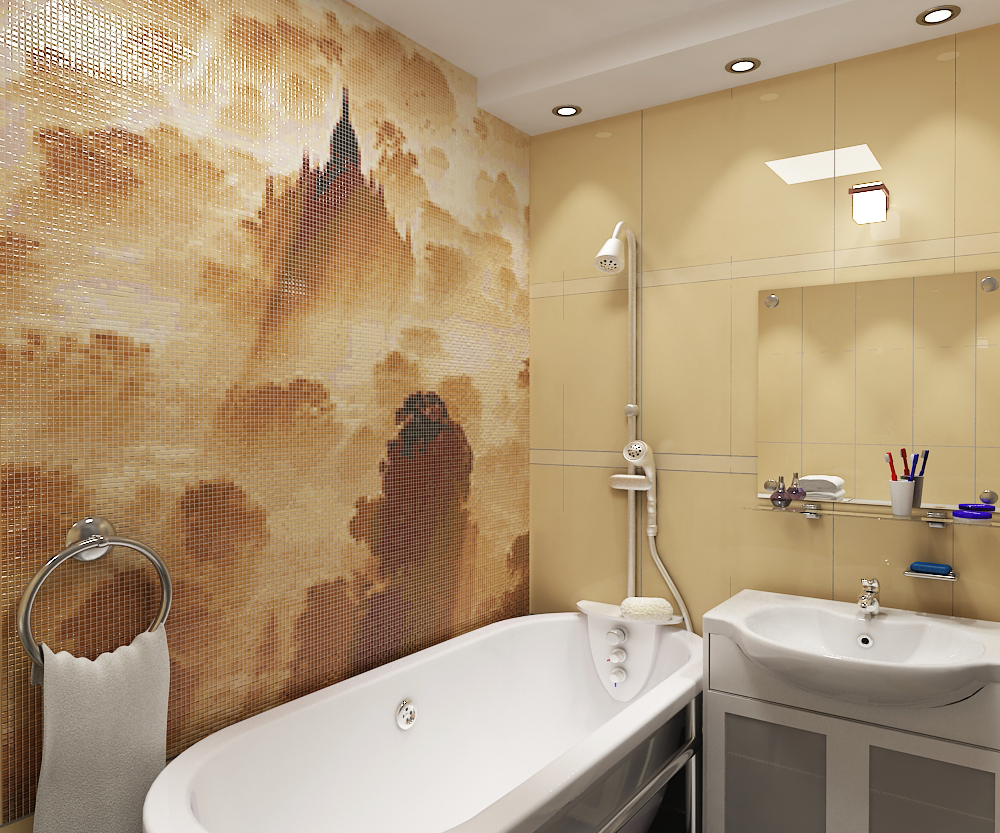
On a modern decorative tile you can capture the landscape
The main types of mosaics in the interior of the bathroom
A huge range of materials for cladding is not limited to colors and sizes. The modern construction market has several basic materials for the manufacture of mosaic tiles.
Ceramic tile
The most common material in the industry. It was widely used due to its relatively low price, a wide range of color solutions, and practicality in operation.

Ceramic mosaic has the widest range and inexpensive price.

Ceramic mosaic with gilding fills the bathroom with a metallic sheen of hi-tech

Ceramic mosaics can successfully simulate natural stone
Glass mosaic
It is made of quartz sand by special heat treatment, which gives the finished product high strength to mechanical stress. This tile can also be used for walls and floors, however it is important to check the material for slipping before facing the floor. The texture of the glass tends to be very slippery, especially when in contact with water. Glass mosaic is ideal for walls, giving the interior a special shine and play of light.
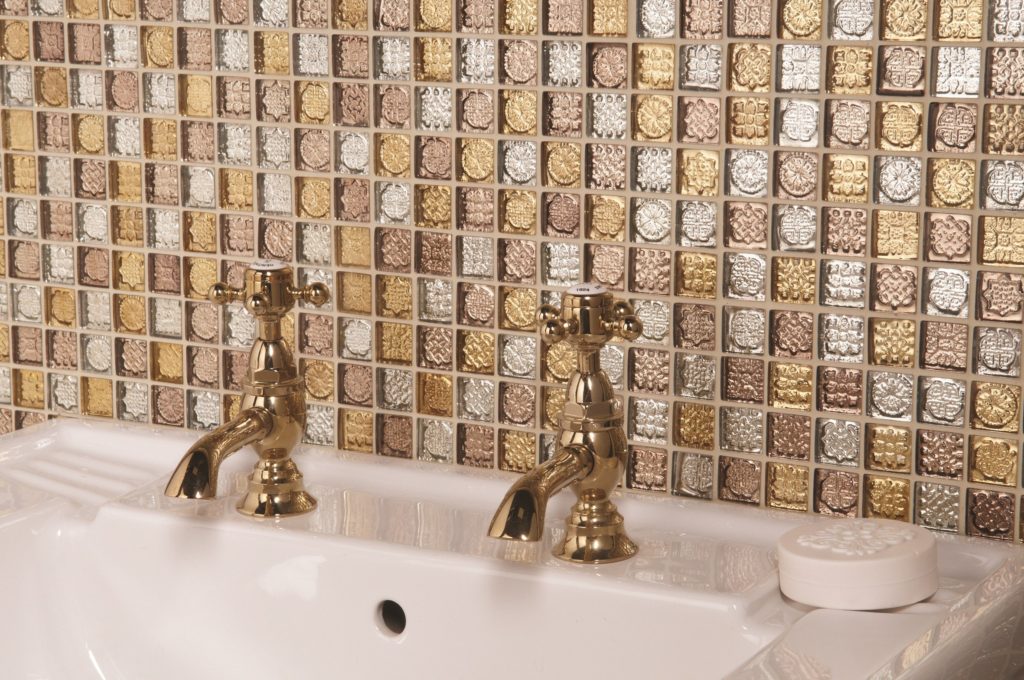
Mosaic of glass tiles of different textures gives an interesting pattern.

The oldest glass mosaic material looks very modern
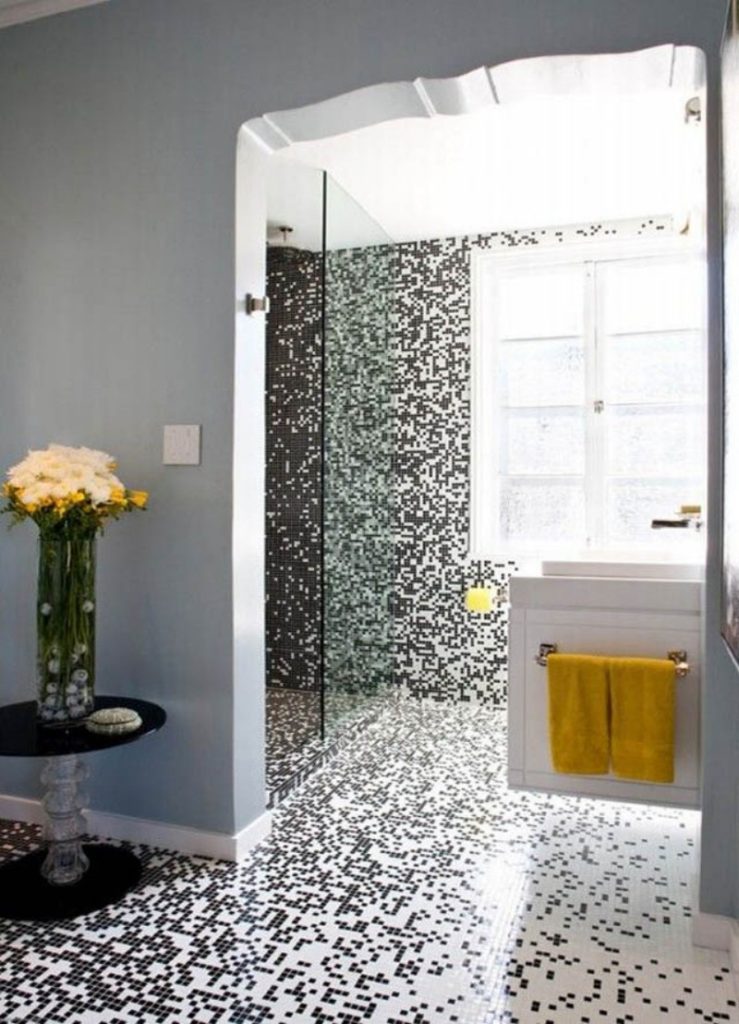
The mosaic of white and black goes well with the gray and white bath
Natural stone tile
Suitable for wall and floor cladding, as it has exceptional mechanical properties and is not prone to chips and scratches. For the manufacture of stones such as marble, jasper, granite and onyx are used. The cost of the product is quite high, but the long service life allows you to pay back the price with interest. Even with direct sunlight, the color quality of the material will not change for many years.
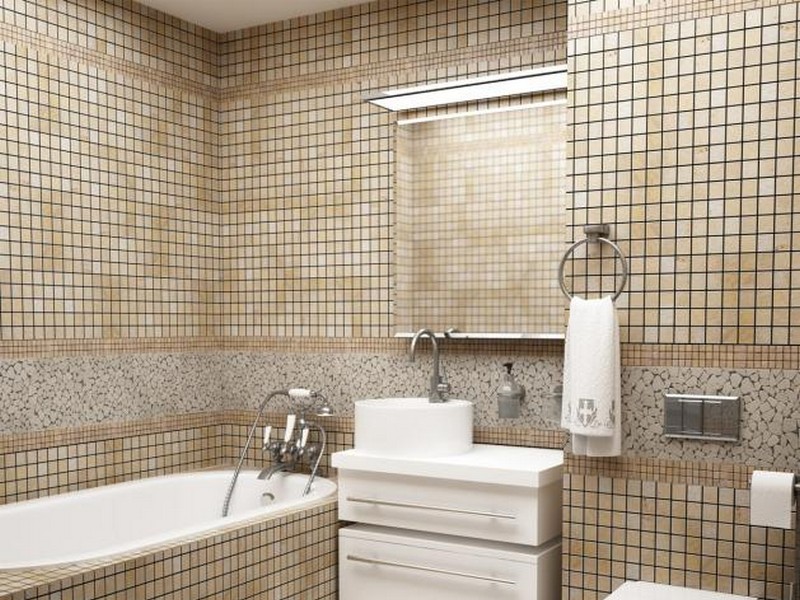
In the middle of ceramic masonry, you can make a strip of natural marble
Stone mosaic has its own classification.
- Roman mosaic - made of stone such as pebbles. The roots of this art originate in ancient Rome, uniting the cultural heritage of Greece and Byzantium. The patterns of paintings made in this style can be many drawings typed with the help of small natural stone.
- Florentine mosaic. The next historical stage of this facing material. In execution, the Florentine mosaic is the most complex, since thin cuts of natural stones, carefully selected by the shape, color and texture of the pattern, became the material for the facing. However, the legacy of this style is truly considered a work of world art.
- Russian style.The latest stage in the development of mosaics arose in the Urals. According to its technology, this species is a continuation of the Florentine trend, however, the peculiarity and distinctive feature of Russian mosaic is considered to be the leaving of the external texture of natural stone in a natural state (that is, the exception of polishing).

The high cost of stone mosaics is offset by a spectacular design and durability

The wall pattern in the shower stall is made of stone mosaic
The process of laying mosaic
Mosaic in the interior of the bathroom with your own hands is not only beautiful, but also quite laborious. The main difficulty of the cladding is preparing the walls to a perfectly flat surface. Therefore, the first stage of work is preliminary preparation. It is important to ensure not only a flat wall, but also to check it for integrity in order to prevent the pieces of plaster from falling off.

Apply start and finish layers of putty

Carefully check and level the walls before gluing the mosaic
After preparing the wall, you can start pasting with mosaic. Facing is carried out using glue, the brand and properties of which depend on the choice of mosaic tiles (there is no universal solution for all occasions). Facing is carried out from the bottom of the wall up to the previously applied adhesive mixture. The glue is applied using a notched trowel, which allows for better adhesion of the tile to the wall.

Apply glue with a notched trowel and start the sticker from the bottom row
Mosaic tiles can be produced in various forms, depending on the base, which may be paper, mesh or absent. Do-it-yourself cladding will be much easier with a base mosaic.
After 48 hours, when the glue hardens completely, you can proceed to grouting. Grouting is carried out with a special building mixture, the color of which depends on the concept of the composition itself. Excess grout must be removed with a damp cloth or sponge 20-30 minutes after the process itself.

After two days, you can start grouting with a special mixture
With inadequate knowledge of building skills, it is better not to engage in independent wall mosaics. In order to make good use of expensive material it is better not to save, and turn to a team of specialists.
Rules and subtleties of facing, expert advice
There are many things that are familiar only to experienced craftsmen. Among the main useful tips for beginning tilers, the following can be distinguished.
- With a small bathroom, you should not experiment with a variety of colors. In this case, two or three bright colors that are in harmony with each other will be most appropriate. If you want a contrasting design, you should limit yourself to only two elements that will strictly merge into a single concept.
- For sanitary units of small sizes, pay attention to the mosaic of small sizes. Such a move will help visually increase the space in the room;
- When facing ornaments of different shades of the same color scheme (as is the case with the marine theme), it is recommended to start with dark tones that will be at the bottom of the wall, gradually brightening the picture to the top.
- When self-laying mosaics, it is recommended to use the canvas exclusively with a paper or mesh substrate. Alluvial mosaic can cause insurmountable difficulties to the master without proper experience in this field.
- For gluing the floor and walls, you need to choose different consistencies of the adhesive mixture. For the floor, it should be elastic, and for the walls - more viscous (otherwise the glue will slide down).
- The glue must be applied portionwise, since application to large areas will lead to its quick drying.
- Due to the excessive moisture in the bathroom, fungus and mold may form at the seams between the mosaics.In order to prevent this trend, it is necessary to carry out planned (approximately once every six months) seams with special chemicals. The tile itself must be washed at least once a week (twice a week in the case of a combined plumbing unit).
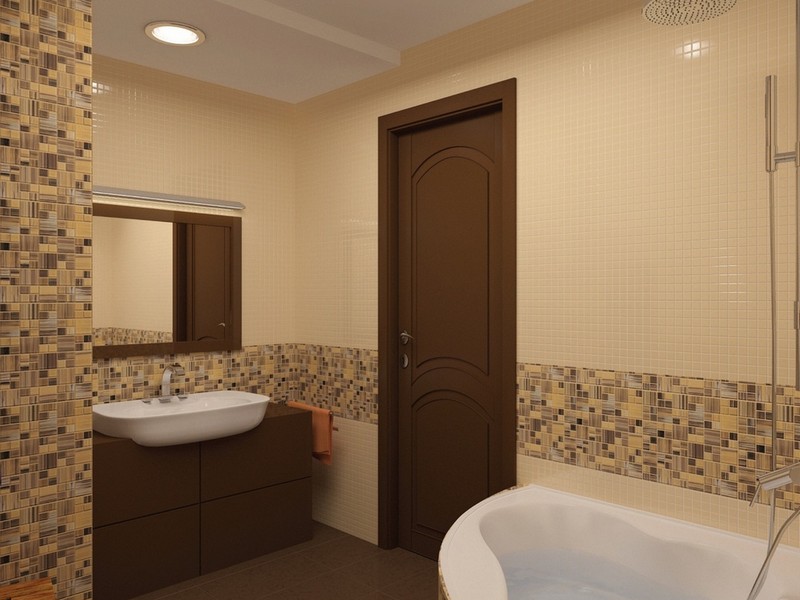
Respect the unity of the color palette of the bathroom

Make a smooth transition of the mosaic from one color to another
In conclusion, it can be noted that the facing of the bathroom with mosaic tiles is one of the best structural solutions. Due to its properties, this material is practical and durable, and a huge assortment of color schemes and patterns will allow you to choose any design for large and small rooms.
Watch a video with examples of mosaics in bathroom design:




